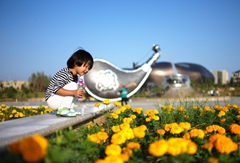Memorial Rituals for Genghis Khan
Updated: 2018-05-08  Print
Print 



This is the highest form of Mongolian worship ceremony. This embodies the ancient Mongolian cultures and is a part of classic folk culture. The rituals were included as the first batch in the National Intangible Cultural Heritage list in 2006 by the State Council.
The rituals have a long history. When Genghis Khan died in 1227, the Mongol Empire built a portable mausoleum (a white yurt) to enshrine him as the "god of all Mongolians".
As relatives of Genghis Khan died, his portable mausoleums and relics gradually increased. Eventually, eight white yurts, or Eight White Palaces, became the primary mausoleums, led by the Mausoleum of Genghis Khan.
His grandson, Kublai Khan built a yellow palace for him in Shangdu (Xanadu), the capital of Yuan Dynasty (1206-1368) in 1264, and the Imperial Ancestral Temple in 1266 in Dadu, another capital, improving the sacrificial system. In 1282, Kublai Khan established several worship ceremonies and assigned officials that dealt with sacrificial affairs to write elegiac addresses, words and verses, which made worship rituals more complete.
In 1696,500 Dalhut households gathered to serve and guard the mausoleums, of which the rituals, for generations have increasingly been perfected and passed down to today.
The rituals preserved by them and Mongols are exactly what were practiced in the 13th century, which worship the Heaven, ancestors and heroes via ancient Mongolian rites of offering fire, milk, wine, livestock and songs.
A variety of precious sacrificial utensils with ethnic features are employed, which were made according to the prairie people's artistic sense of the nature and animals.
The rituals include sacrifice to Eight White Palaces, the black Sulde (the God of war) and the holy relics of the Khan.
Apart from daily worship, dozens of special rituals are held annually in unique forms. With rich content and a large scale, they reveal the old and mysterious traditional cultures.
The memorial rituals for Genghis Khan have constantly been improved over history and grown systematic, while being completed with distinct characteristics.
There are different types of mysterious, unsolved puzzles in these rituals, including the objects of worship, rites, forms, sacrifices, elegiac addresses and utensils. The methods that people use to pass on these rituals are absolutely unique and can't be found anywhere else on the entire world.





 Ordos Impression
Ordos Impression Ordos WeChat
Ordos WeChat Ordos Reported
Ordos Reported


